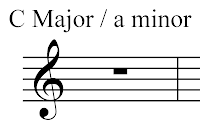Meter is the grouping of beat patterns. Certain beats are stressed more than others in music and this causes the beats to fall into perceptible patterns. These patterns almost always come in twos or threes.
Fundamental Meter Groupings:
These meters are the most basic meters. Almost all of the other meters are some combination of these two.
- Duple: [1 - 2], [1 - 2], [1 - 2], [1 - 2], etc.
- Triple: [1 - 2 - 3], [1 - 2 - 3], [1 - 2 - 3], [1 - 2 - 3], etc.
Other Meters:
- [1 - 2 - 3 - 4], [1 - 2 - 3 - 4], [1 - 2 - 3 - 4], etc.
- [1 - 2 - 3 - 4 - 5 - 6], [1 - 2 - 3 - 4 - 5 - 6], etc.
- [1 - 2 - 3 - 4 - 5], [1 - 2 - 3 - 4 - 5], etc.
- Many other meters are possible.
Meter, Beat and Tempo:
The Beat and Meter can change depending upon Tempo. For example, in a slow tempo a meter of [123] is usually a group of three beats. In a fast tempo the beat is felt as: [1], [1], [1], etc.







 In the above example the top number is 3: This tells us that there are 3 beats in a measure. The bottom number tells us that the
In the above example the top number is 3: This tells us that there are 3 beats in a measure. The bottom number tells us that the 

















 The note names in Alto Clef are:
The note names in Alto Clef are:
 The note names in Tenor Clef are:
The note names in Tenor Clef are:
 With the blank staff we can't yet tell what notes to play. We use Clefs to tell us which notes correspond to which lines or spaces. The most common clefs are the Treble Clef (also known as the G Clef) and the Bass Clef (or F Clef).
With the blank staff we can't yet tell what notes to play. We use Clefs to tell us which notes correspond to which lines or spaces. The most common clefs are the Treble Clef (also known as the G Clef) and the Bass Clef (or F Clef).


 The Bass Clef has two dots, above and below the second line from the top. The dots tell us that this line is F.
The Bass Clef has two dots, above and below the second line from the top. The dots tell us that this line is F. The note names in Bass Clef are:
The note names in Bass Clef are:





